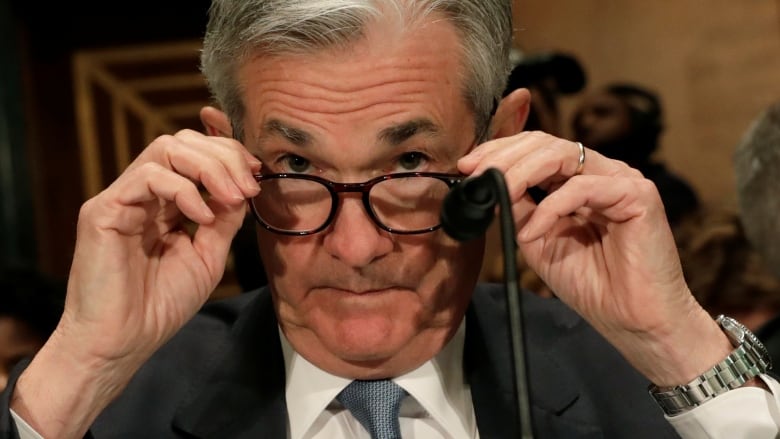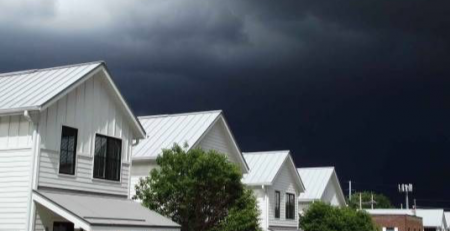Canadian borrowers will feel this week’s U.S. interest rate hike
[CBC News – September 24, 2018]
The world’s biggest central bank is expected to raise rates this week — and then keep raising them.
With two eyes on the future, U.S. Federal Reserve chair Jerome Powell is expected to raise interest rates this week — and then keep raising them to keep inflation under control. (Yuri Gripas/Reuters)
Markets are so certain that U.S. Federal Reserve chair Jerome Powell will raise rates this week that a failure to hike would likely have worse consequences for American markets than the impact of higher borrowing costs.
But the near certainty so cherished by market traders — who hate rude surprises — will provide little reassurance for the millions of people around the world, including over-borrowed Canadians, who will inevitably feel the effects of higher rates.
And not only are market indicators showing a 100 per cent expectation of a rate hike on Wednesday, most analysts expect another increase in December, with predictions of as many as four more quarter-point increases in 2019.
Mortgage impact:
Canadians struggling with mortgage payments and other debt must take that into account, because the actions of the world’s most powerful central bank don’t stop at the border.
That’s because in a large, open economy like the United States, what that country’s central bank does as manager of the world’s reserve currency will have impacts around the world, says Murshed Chowdhury, a specialist in international economics at the University of New Brunswick.
Despite of all the talk of trade squabbles and tariffs, the U.S. and Canadian economies remain joined at the hip, Chowdhury says. “In many ways, we are integrated,” he said.
The fact that the Bank of Canada has not yet raised rates as much as the Fed does not protect Canadians from U.S. increases, although the path from U.S. interest rates to your mortgage may be circuitous.
“The cost of borrowing will rise for Canadians, as well as for emerging markets,” said Chowdhury.
What happens with U.S. interest rates creeps across borders in a variety of ways.
One way is that many large business and government loans are priced in U.S. dollars. This has had a huge impact on countries such as Argentina and Turkey, making their current troubles worse.
As their own currencies have declined due to economic or political crises at home, international loans denominated in U.S. dollars become increasingly unmanageable. Renewing those loans will come at the higher U.S. rate in a pricier U.S. currency.
One thing that happens is that as U.S. rates increase compared to other countries, international investors tend to move into U.S. dollars, increasing the value of the U.S. dollar versus other world currencies.
It is something with which Canadians are familiar. Other things being equal, rising U.S. rates mean the greenback climbs relative to the loonie. And that has a direct impact on Canadians, making foreign goods more expensive and, in turn, pushing up Canadian inflation.
One full percentage point in 2019?
Until recently, U.S. bond traders had been skeptical of the Fed’s forecast for rising rates. But according to Bloomberg, that has begun to change.
“Investors in recent weeks have moved closer to the Federal Reserve’s projected path of three rate hikes next year,” Bloomberg reported.
Not only that, but a growing number of financial analysts, including those at the Royal Bank of Canada, have upped that forecast to four rate hikes next year. For U.S. borrowers, that would mean another whole percentage point increase in interest payments on renewed mortgages and lines of credit.
While the Bank of Canada doesn’t raise rates in lockstep with the Fed, it does tend to follow suit after a respectable interval, which has in the past kept short-term rates roughly at pace. One reason is the imported inflation mentioned above. And core inflation, now above two per cent in Canada, is what tells our central bankers when to hike rates.
“There’s a whole bunch of uncertainties,” said Chowdhury. An as-of-yet unresolved NAFTA and signs of an escalating trade war between China and the United States could make governments reconsider rate hikes, he says.
But that’s not what U.S. stock markets were telling us last week, hitting new record highs on Thursday and Friday. Some analysts said the market rise showed traders were brushing off concerns about the impact of trade on the global economy.
But in the circular, almost-incestuous way of markets, another reason could have been the rush to get out of bonds in anticipation of a decline in bond prices as interest rates rise. (See this backgrounder for a refresher on the sometimes-confusing relationship between rising interest rates and falling bond prices.)
There are other strange feedback loops in the expectations for rate increases.
Even as the OECD worries that trade disputes are hurting global growth, those same trade conflicts are expected to push prices higher. Last week, retail giant Walmart, which carries many Chinese-made products, warned of price hikes.
The Trump administration’s push to keep immigrants out of the U.S. may also be contributing to wage inflation as employers compete for existing workers.
Although both could be bad for the U.S. economy in the longer term, the Fed’s strong urge to keep inflation expectations from flying out of control would be one more reason for a trend toward rising rates.











